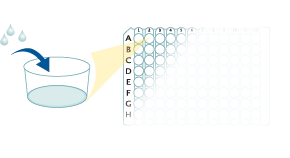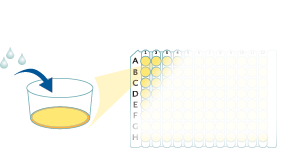Human CXCL11/I-TAC Quantikine ELISA Kit Summary
Product Summary
Recovery
The recovery of I-TAC spiked to levels throughout the range of the assay in various matrices was evaluated.
| Sample Type | Average % Recovery | Range % |
|---|---|---|
| Cell Culture Media (n=4) | 100 | 91-111 |
| EDTA Plasma (n=5) | 98 | 85-112 |
| Heparin Plasma (n=5) | 98 | 90-106 |
| Serum (n=5) | 106 | 93-117 |
Linearity
Scientific Data
Product Datasheets
Preparation and Storage
Background: CXCL11/I-TAC
Interferon-inducible T cell a chemoattractant (I-TAC), also known as SCYB9B, H174 and beta-R1, is a non-ELR motif-containing CXC chemokine. I-TAC shares 36% and 37% amino acid sequence homology with IP-10 and MIG, respectively. I-TAC is expressed at low levels in normal tissues, including thymus, spleen and pancreas.
Assay Procedure
Refer to the product- Prepare all reagents, standard dilutions, and samples as directed in the product insert.
- Remove excess microplate strips from the plate frame, return them to the foil pouch containing the desiccant pack, and reseal.
- Add 100 µL of Assay Diluent to each well.
- Add 100 µL of Standard, control, or sample to each well. Cover with a plate sealer, and incubate at room temperature for 2 hours.
- Aspirate each well and wash, repeating the process 3 times for a total of 4 washes.
- Add 200 µL of Conjugate to each well. Cover with a new plate sealer, and incubate at room temperature for 2 hours.
- Aspirate and wash 4 times.
- Add 200 µL Substrate Solution to each well. Incubate at room temperature for 30 minutes. PROTECT FROM LIGHT.
- Add 50 µL of Stop Solution to each well. Read at 450 nm within 30 minutes. Set wavelength correction to 540 nm or 570 nm.





Citations for Human CXCL11/I-TAC Quantikine ELISA Kit
R&D Systems personnel manually curate a database that contains references using R&D Systems products. The data collected includes not only links to publications in PubMed, but also provides information about sample types, species, and experimental conditions.
28
Citations: Showing 1 - 10
Filter your results:
Filter by:
-
Characterization and optimization of variability in a human colonic epithelium culture model
Authors: Pike, CM;Zwarycz, B;McQueen, BE;Castillo, M;Barron, C;Morowitz, JM;Levi, JA;Phadke, D;Balik-Meisner, M;Mav, D;Shah, R;Glasspoole, DLC;Laetham, R;Thelin, W;Bunger, MK;Boazak, EM;
bioRxiv : the preprint server for biology
Species: Human
Sample Types: Cell Culture Supernates
-
Colon cancer cells secreted CXCL11 via RBP-Jkappa to facilitated tumour-associated macrophage-induced cancer metastasis
Authors: M Liu, X Fu, L Jiang, J Ma, X Zheng, S Wang, H Guo, T Tian, K Nan, W Wang
Journal of Cellular and Molecular Medicine, 2021-10-16;0(0):.
Species: Human
Sample Types: Cell Culture Supernates
-
Interferon-gamma-Inducible Chemokines as Prognostic Markers for Lung Cancer
Authors: KS Lee, WY Chung, JE Park, YJ Jung, JH Park, SS Sheen, KJ Park
International Journal of Environmental Research and Public Health, 2021-09-04;18(17):.
Species: Human
Sample Types: Serum
-
Nanoparticle-Mediated Delivery of 2-Deoxy-D-Glucose Induces Antitumor Immunity and Cytotoxicity in Liver Tumors in Mice
Authors: K Sasaki, S Nishina, A Yamauchi, K Fukuda, Y Hara, M Yamamura, K Egashira, K Hino
Cell Mol Gastroenterol Hepatol, 2020-10-24;0(0):.
Species: Human
Sample Types: Cell Culture Supernates
-
Obesity in acute alcoholic hepatitis increases morbidity and mortality
Authors: R Parker, SJ Kim, GY Im, J Nahas, B Dhesi, N Vergis, A Sinha, A Ghezzi, MR Rink, A McCune, GP Aithal, PN Newsome, CJ Weston, A Holt, B Gao
EBioMedicine, 2019-07-03;45(0):511-518.
Species: Human
Sample Types: Serum
-
VSIG-3 as a ligand of VISTA inhibits human T-cell function.
Authors: Wang J, Wu G, Manick B, Hernandez V, Renelt M, Erickson C, Guan J, Singh R, Rollins S, Solorz A, Bi M, Li J, Grabowski D, Dirkx J, Tracy C, Stuart T, Ellinghuysen C, Desmond D, Foster C, Kalabokis V
Immunology, 2018-10-10;156(1):74-85.
Species: Human
Sample Types: Cell Culture Supernates
-
Inflammatory Differences in Plaque Erosion and Rupture in Patients With ST-Segment Elevation Myocardial Infarction
Authors: S Chandran, J Watkins, A Abdul-Aziz, M Shafat, PA Calvert, KM Bowles, MD Flather, SA Rushworth, AD Ryding
J Am Heart Assoc, 2017-05-03;6(5):.
Species: Human
Sample Types: Plasma
-
Salt suppresses IFN? inducible chemokines through the IFN?-JAK1-STAT1 signaling pathway in proximal tubular cells
Authors: Y Arai, D Takahashi, K Asano, M Tanaka, M Oda, SBH Ko, MSH Ko, S Mandai, N Nomura, T Rai, S Uchida, E Sohara
Sci Rep, 2017-04-20;7(0):46580.
Species: Human
Sample Types: Cell Culture Supernates
-
Left Ventricular Dysfunction and CXCR3 Ligands in Hypertension: From Animal Experiments to a Population-Based Pilot Study.
Authors: Altara R, Gu Y, Struijker-Boudier H, Thijs L, Staessen J, Blankesteijn W
PLoS ONE, 2015-10-27;10(10):e0141394.
Species: Human
Sample Types: Plasma
-
Effective Apical Infection of Differentiated Human Bronchial Epithelial Cells and Induction of Proinflammatory Chemokines by the Highly Pneumotropic Human Adenovirus Type 14p1.
Authors: Lam E, Ramke M, Warnecke G, Schrepfer S, Kopfnagel V, Dobner T, Heim A
PLoS ONE, 2015-07-13;10(7):e0131201.
Species: Human
Sample Types: Cell Culture Supernates
-
Expression of CXCR3 and its ligands CXCL9, -10 and -11 in paediatric opsoclonus-myoclonus syndrome.
Authors: Pranzatelli M, Tate E, McGee N, Travelstead A, Verhulst S, Ransohoff R
Clin Exp Immunol, 2013-06-01;172(3):427-36.
Species: Human
Sample Types: Serum
-
Human cytomegalovirus IE1 protein elicits a type II interferon-like host cell response that depends on activated STAT1 but not interferon-gamma.
Authors: Knoblach T, Grandel B, Seiler J, Nevels M, Paulus C
PLoS Pathog., 2011-04-14;7(4):e1002016.
Species: Human
Sample Types: Cell Culture Supernates
-
NOD1 contributes to mouse host defense against Helicobacter pylori via induction of type I IFN and activation of the ISGF3 signaling pathway.
Authors: Watanabe T, Asano N, Fichtner-Feigl S, Gorelick PL, Tsuji Y, Matsumoto Y, Chiba T, Fuss IJ, Kitani A, Strober W
J. Clin. Invest., 2010-04-12;120(5):1645-62.
Species: Human
Sample Types: Cell Culture Supernates
-
Expression of CXCL9, -10, -11, and CXCR3 in the tear film and ocular surface of patients with dry eye syndrome.
Authors: Yoon KC, Park CS, You IC, Choi HJ, Lee KH, Im SK, Park HY, Pflugfelder SC
Invest. Ophthalmol. Vis. Sci., 2009-10-22;51(2):643-50.
Species: Human
Sample Types: Tears
-
The imbalance in serum concentration of Th-1- and Th-2-derived chemokines as one of the factors involved in pathogenesis of atopic dermatitis.
Authors: Narbutt J, Lesiak A, Sysa-Jedrzeiowska A, Zakrzewski M, Bogaczewicz J, Stelmach I, Kuna P
Mediators Inflamm., 2009-07-22;2009(0):269541.
Species: Human
Sample Types: Serum
-
CXCR3 ligands are augmented during the pathogenesis of pulmonary sarcoidosis.
Authors: Busuttil A, Weigt SS, Keane MP, Xue YY, Palchevskiy V, Burdick MD, Huang C, Zisman DA, Fishbein M, Lynch JP, Strieter RM, Elashoff RM, Belperio JA
Eur. Respir. J., 2009-04-22;34(3):676-86.
Species: Human
Sample Types: BALF
-
Villitis of unknown etiology is associated with a distinct pattern of chemokine up-regulation in the feto-maternal and placental compartments: implications for conjoint maternal allograft rejection and maternal anti-fetal graft-versus-host disease.
Authors: Kim MJ, Romero R, Kim CJ, Tarca AL, Chhauy S, LaJeunesse C, Lee DC, Draghici S, Gotsch F, Kusanovic JP, Hassan SS, Kim JS
J. Immunol., 2009-03-15;182(6):3919-27.
Species: Human
Sample Types: Plasma
-
Infiltrated neutrophils acquire novel chemokine receptor expression and chemokine responsiveness in chronic inflammatory lung diseases.
Authors: Hartl D, Krauss-Etschmann S, Koller B, Hordijk PL, Kuijpers TW, Hoffmann F, Hector A, Eber E, Marcos V, Bittmann I, Eickelberg O, Griese M, Roos D
J. Immunol., 2008-12-01;181(11):8053-67.
Species: Human
Sample Types: BALF
-
The antibacterial chemokine MIG/CXCL9 is constitutively expressed in epithelial cells of the male urogenital tract and is present in seminal plasma.
Authors: Linge HM, Collin M, Giwercman A, Malm J, Bjartell A, Egesten A
J. Interferon Cytokine Res., 2008-03-01;28(3):191-6.
Species: Human
Sample Types: Seminal Plasma
-
CXCR3 and CCR5 chemokines in induced sputum from patients with COPD.
Authors: Costa C, Rufino R, Traves SL, Lapa E Silva JR, Barnes PJ, Donnelly LE
Chest, 2007-10-09;133(1):26-33.
Species: Human
Sample Types: Saliva
-
Th1/Th2 cytokines reciprocally regulate in vitro pulmonary angiogenesis via CXC chemokine synthesis.
Authors: Matsuda A, Fukuda S, Matsumoto K, Saito H
Am. J. Respir. Cell Mol. Biol., 2007-08-20;38(2):168-75.
Species: Human
Sample Types: Cell Culture Supernates
-
Chemokines CXCL10 and CXCL11 in the cerebrospinal fluid of patients with tick-borne encephalitis.
Authors: Lepej SZ, Misic-Majerus L, Jeren T, Rode OD, Remenar A, Sporec V, Vince A
Acta Neurol. Scand., 2007-02-01;115(2):109-14.
Species: Human
Sample Types: Serum
-
Prolactin enhances interferon-gamma-induced production of CXC ligand 9 (CXCL9), CXCL10, and CXCL11 in human keratinocytes.
Authors: Kanda N, Watanabe S
Endocrinology, 2007-01-25;148(5):2317-25.
Species: Human
Sample Types: Cell Culture Supernates
-
IFN-gamma alters the response of Borrelia burgdorferi-activated endothelium to favor chronic inflammation.
Authors: Dame TM, Orenzoff BL, Palmer LE, Furie MB
J. Immunol., 2007-01-15;178(2):1172-9.
Species: Human
Sample Types: Cell Culture Supernates
-
Different angiogenic activity in pulmonary sarcoidosis and idiopathic pulmonary fibrosis.
Authors: Antoniou KM, Tzouvelekis A, Alexandrakis MG, Sfiridaki K, Tsiligianni I, Rachiotis G, Tzanakis N, Bouros D, Milic-Emili J, Siafakas NM
Chest, 2006-10-01;130(4):982-8.
Species: Human
Sample Types: BALF
-
IL-17 enhances the net angiogenic activity and in vivo growth of human non-small cell lung cancer in SCID mice through promoting CXCR-2-dependent angiogenesis.
Authors: Numasaki M, Watanabe M, Suzuki T, Takahashi H, Nakamura A, McAllister F, Hishinuma T, Goto J, Lotze MT, Kolls JK, Sasaki H
J. Immunol., 2005-11-01;175(9):6177-89.
Species: Human
Sample Types: Cell Culture Supernates
-
Increased expression of CXCR3 and CCR5 on memory CD4+ T-cells migrating into the cerebrospinal fluid of patients with neuroborreliosis: the role of CXCL10 and CXCL11.
Authors: Lepej SZ, Rode OD, Jeren T, Vince A, Remenar A, Barsic B
J. Neuroimmunol., 2005-04-19;163(1):128-34.
Species: Human
Sample Types: Serum
-
CXCR3 and CCR5 positive T-cell recruitment in acute human renal allograft rejection.
Authors: Panzer U, Reinking RR, Steinmetz OM, Zahner G, Sudbeck U, Fehr S, Pfalzer B, Schneider A, Thaiss F, Mack M, Conrad S, Huland H, Helmchen U, Stahl RA
Transplantation, 2004-11-15;78(9):1341-50.
Species: Human
Sample Types: Urine
FAQs
No product specific FAQs exist for this product, however you may
View all ELISA FAQsReviews for Human CXCL11/I-TAC Quantikine ELISA Kit
Average Rating: 4.5 (Based on 2 Reviews)
Have you used Human CXCL11/I-TAC Quantikine ELISA Kit?
Submit a review and receive an Amazon gift card.
$25/€18/£15/$25CAN/¥75 Yuan/¥2500 Yen for a review with an image
$10/€7/£6/$10 CAD/¥70 Yuan/¥1110 Yen for a review without an image
Filter by:
Not detected in urine at 2-fold. Detected in low concentration in plasma at 10-fold. No matrix effects detected.







